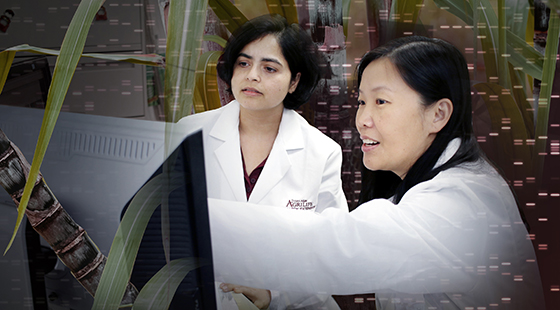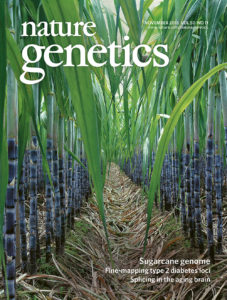AgriLife scientists: Sugarcane genome sequencing a big first step toward better varieties

Writer: Gabe Saldana, 956-408-504, [email protected]
Contact: Dr. Qingyi Yu, 972-952-9225, [email protected]
DALLAS — Sequencing the especially complex genome of sugarcane is one of the significant achievements of agricultural science in 2018, appearing as the cover story of the international science journal Nature Genetics in November.
The accomplishment is a step toward molecular interventions that could one day allow sugarcane crop improvements to take place over shorter periods of time and with greater efficiency than is possible today, said Dr. Qingyi Yu, Texas A&M AgriLife Research genomics scientist in Dallas.

Yu is a co-author of the publication alongside Dr. Anupma Sharma — a postdoctoral research associate in her lab during most of the five-year sequencing initiative. The full publication is available at https://tinyurl.com/sugarcanegenome.
Improving a global crop
Today, sugarcane improvement relies on traditional crossbreeding and field trials, which can take more than a decade and provide no guarantee of viable cultivars. But sequencing the wild sugarcane species Saccharum spontaneum by more than 100 international scientists moves the world closer to faster production of higher quality varieties, which are more resistant to disease and environmental stresses, Yu said.
Sugarcane is the largest crop or livestock product produced by weight in the world, and it is ranked ninth by dollar value, according to the Food and Agriculture Organization of the United Nations. It also is one of the last food crops to undergo sequencing, due to its complex genome, which contains eight to 14 versions of each pair of chromosomes in its cell nucleus.
Sequencing challenges
The extra chromosomes bring a corresponding large amount of DNA to sequence, Yu said. And similar sequences occurring along the genome increase difficulty in assembling them into distinct chromosomes.
Yu’s lab in Dallas was responsible for constructing bacterial artificial chromosome, or BAC, libraries of S. spontaneum. They used these DNA fragments to help sort out homologous chromosomes in the species and assist in quickening the sequence assembly.
S. spontaneum was chosen for sequencing due to its superior disease resistance. The effort revealed more about why resistance is higher in the species, and about the underlying genetic mechanisms contributing to its resilience, Yu said.
Meanwhile, during her time with AgriLife Research, Sharma was instrumental in understanding the species’ evolution, Yu said. Her contributions included identifying transposable elements — DNA sequences that can change positions within a genome — in the sugarcane genome for insights.
The effort produced discoveries about the origins of modern sugarcane’s sweetness, and about hybridization between S. spontaneum and Saccharum officinarum — hybrids of which comprise the most common production varieties of sugarcane today.
Next steps
“The sequencing was a big first step,” Yu said. “But there is much work left to do before we can think about improving actual crop plants.”
Her lab at the Texas A&M AgriLife Research and Extension Center at Dallas now works alongside the international team of researchers to sequence S. officinarum — the next step toward sugarcane crop improvement over the long term.
“The methods developed over this five-year process have provided great insights on how we can produce more high-quality sequences of other complex genomes in the future,” Yu said.


